steering TOYOTA AURIS 2017 (in English) Owner's Manual
[x] Cancel search | Manufacturer: TOYOTA, Model Year: 2017, Model line: AURIS, Model: TOYOTA AURIS 2017Pages: 661, PDF Size: 26.83 MB
Page 179 of 661
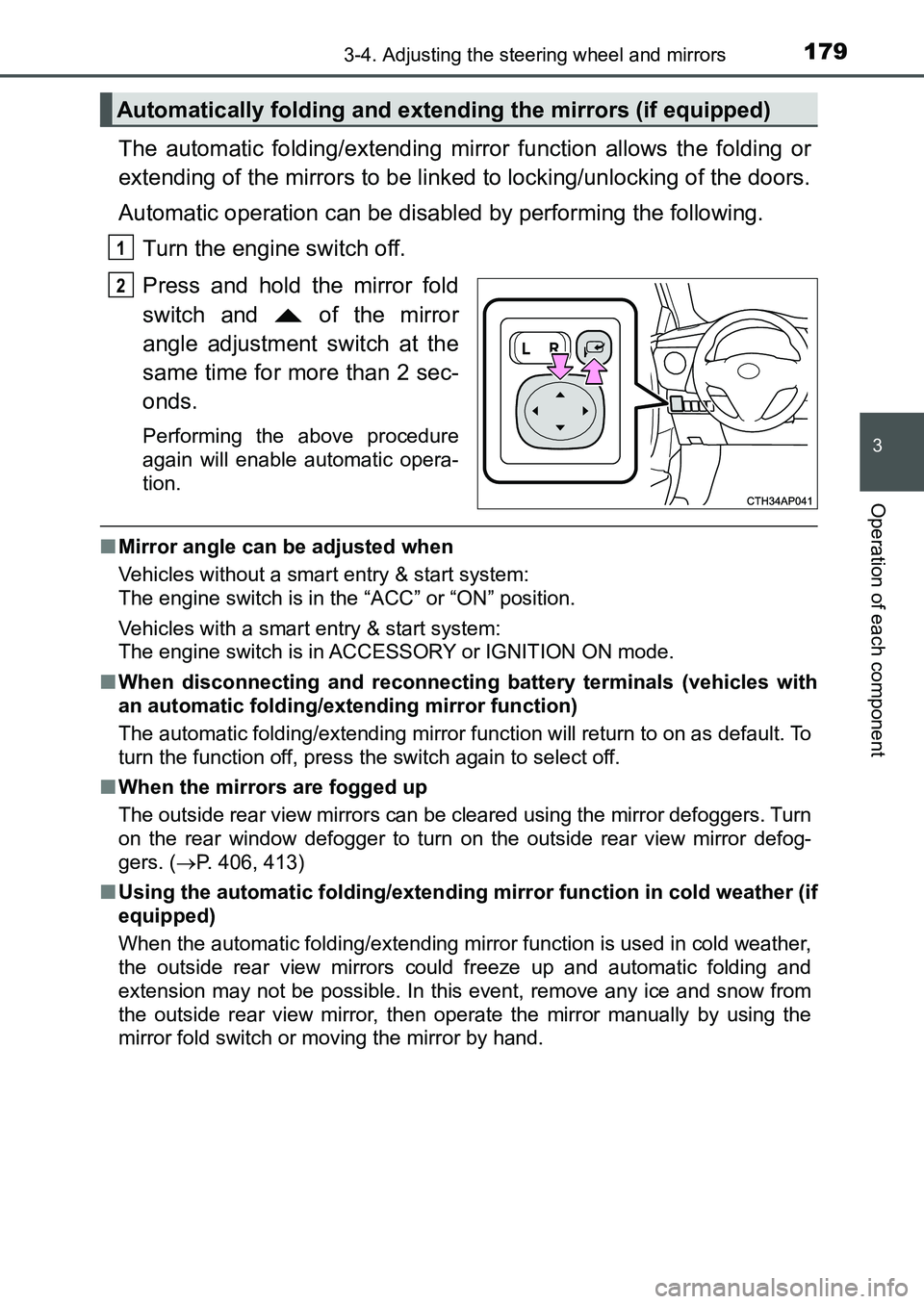
1793-4. Adjusting the steering wheel and mirrors
UK AURIS_HB_EE (OM12K97E)
3
Operation of each component
The automatic folding/extending mirror function allows the folding or
extending of the mirrors to be linked to locking/unlocking of the doors.
Automatic operation can be disabled by performing the following.
Turn the engine switch off.
Press and hold the mirror fold
switch and of the mirror
angle adjustment switch at the
same time for more than 2 sec-
onds.
Performing the above procedure
again will enable automatic opera-
tion.
■Mirror angle can be adjusted when
Vehicles without a smart entry & start system:
The engine switch is in the “ACC” or “ON” position.
Vehicles with a smart entry & start system:
The engine switch is in ACCESSORY or IGNITION ON mode.
■When disconnecting and reconnecting battery terminals (vehicles with
an automatic folding/extending mirror function)
The automatic folding/extending mirror function will return to on as default. To
turn the function off, press the switch again to select off.
■When the mirrors are fogged up
The outside rear view mirrors can be cleared using the mirror defoggers. Turn
on the rear window defogger to turn on the outside rear view mirror defog-
gers. (P. 406, 413)
■Using the automatic folding/extending mirror function in cold weather (if
equipped)
When the automatic folding/extending mirror function is used in cold weather,
the outside rear view mirrors could freeze up and automatic folding and
extension may not be possible. In this event, remove any ice and snow from
the outside rear view mirror, then operate the mirror manually by using the
mirror fold switch or moving the mirror by hand.
Automatically folding and extending the mirrors (if equipped)
1
2
UK AURIS_HB_OM_Europe_OM12K97E.book 179 ページ 2016年6月27日 月曜日 午後5時42分
Page 180 of 661
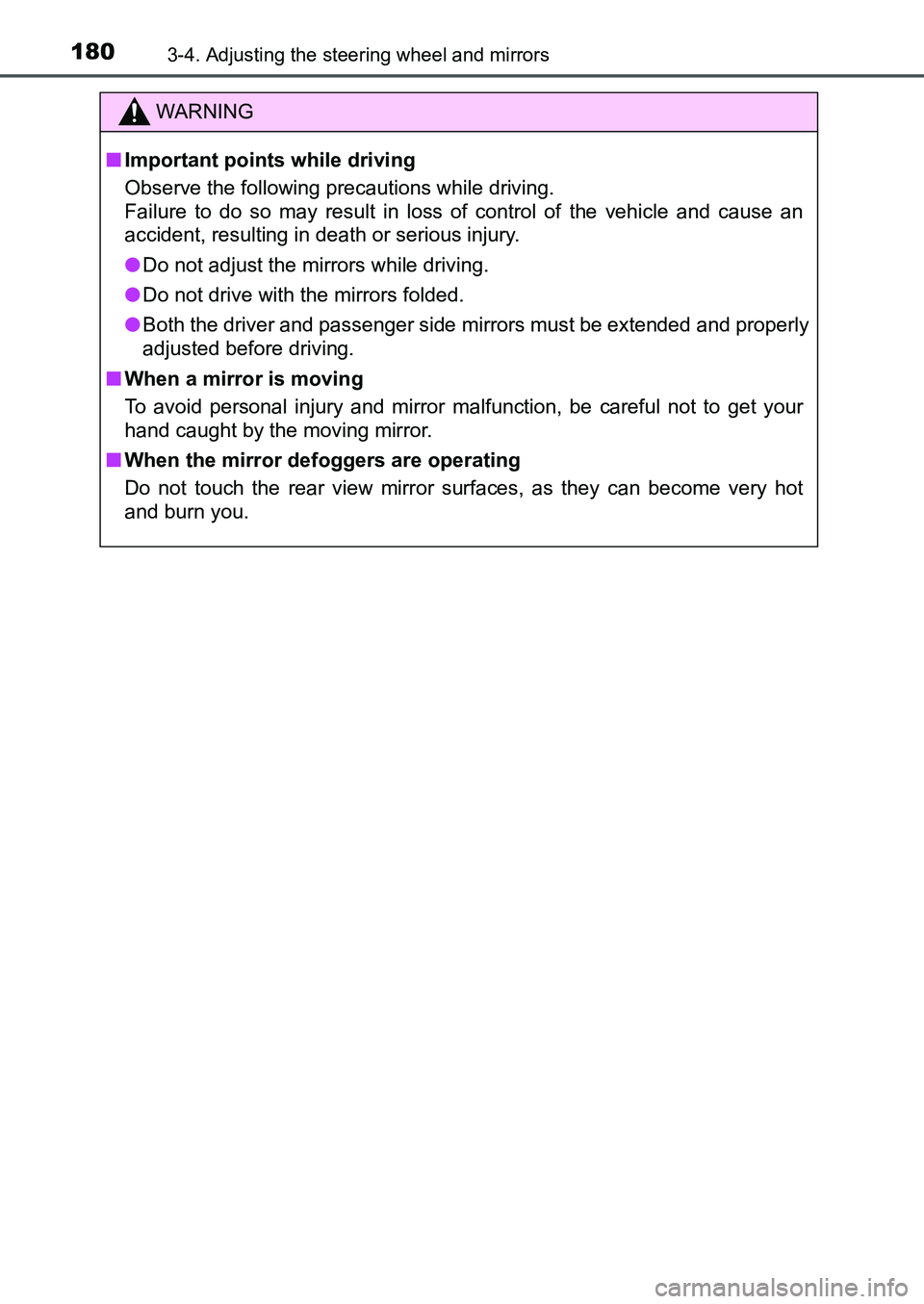
1803-4. Adjusting the steering wheel and mirrors
UK AURIS_HB_EE (OM12K97E)
WARNING
■Important points while driving
Observe the following precautions while driving.
Failure to do so may result in loss of control of the vehicle and cause an
accident, resulting in death or serious injury.
●Do not adjust the mirrors while driving.
●Do not drive with the mirrors folded.
●Both the driver and passenger side mirrors must be extended and properly
adjusted before driving.
■When a mirror is moving
To avoid personal injury and mirror malfunction, be careful not to get your
hand caught by the moving mirror.
■When the mirror defoggers are operating
Do not touch the rear view mirror surfaces, as they can become very hot
and burn you.
UK AURIS_HB_OM_Europe_OM12K97E.book 180 ページ 2016年6月27日 月曜日 午後5時42分
Page 189 of 661
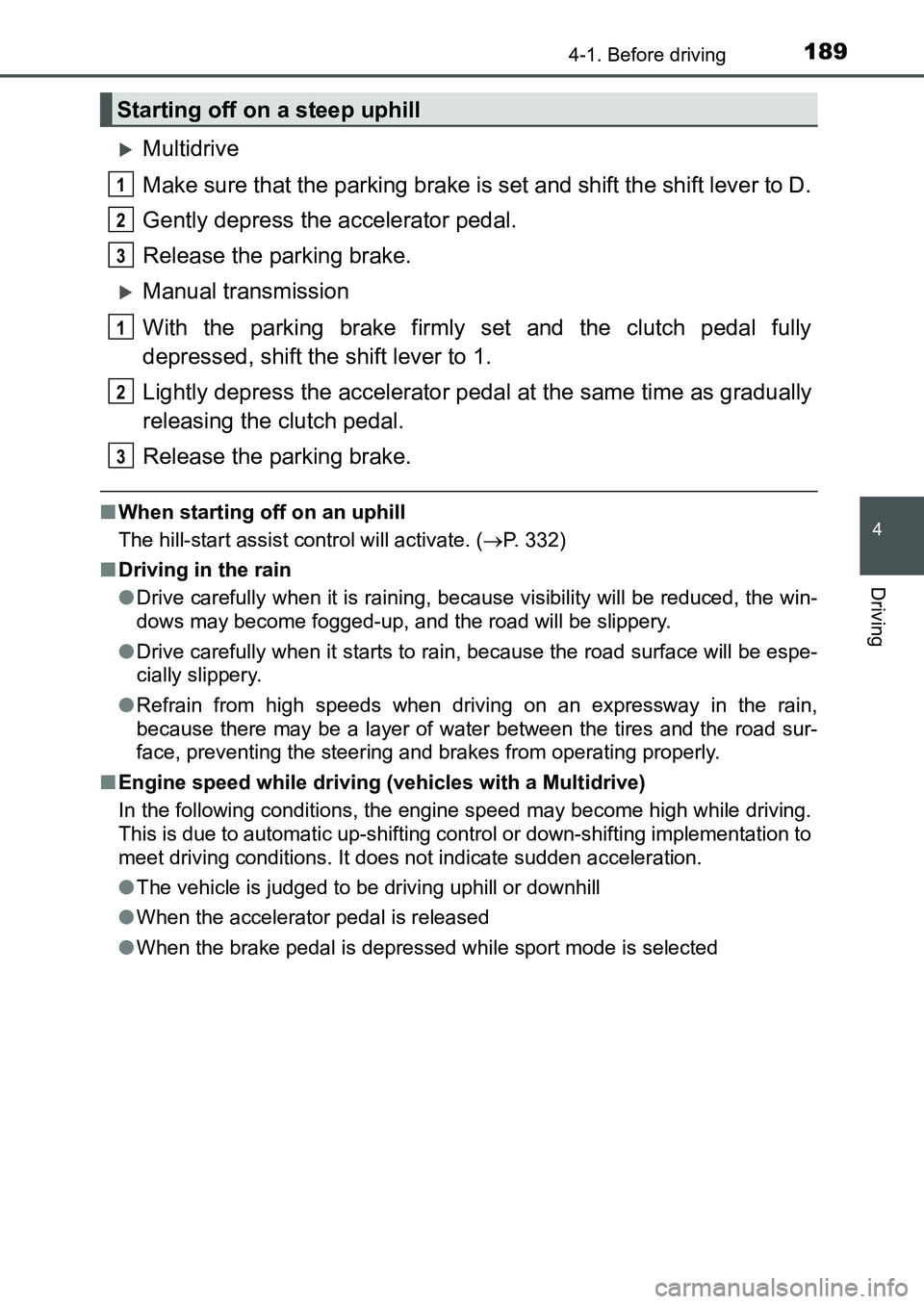
1894-1. Before driving
UK AURIS_HB_EE (OM12K97E)
4
Driving
Multidrive
Make sure that the parking brake is set and shift the shift lever to D.
Gently depress the accelerator pedal.
Release the parking brake.
Manual transmission
With the parking brake firmly set and the clutch pedal fully
depressed, shift the shift lever to 1.
Lightly depress the accelerator pedal at the same time as gradually
releasing the clutch pedal.
Release the parking brake.
■When starting off on an uphill
The hill-start assist control will activate. (P. 332)
■Driving in the rain
●Drive carefully when it is raining, because visibility will be reduced, the win-
dows may become fogged-up, and the road will be slippery.
●Drive carefully when it starts to rain, because the road surface will be espe-
cially slippery.
●Refrain from high speeds when driving on an expressway in the rain,
because there may be a layer of water between the tires and the road sur-
face, preventing the steering and brakes from operating properly.
■Engine speed while driving (vehicles with a Multidrive)
In the following conditions, the engine speed may become high while driving.
This is due to automatic up-shifting control or down-shifting implementation to
meet driving conditions. It does not indicate sudden acceleration.
●The vehicle is judged to be driving uphill or downhill
●When the accelerator pedal is released
●When the brake pedal is depressed while sport mode is selected
Starting off on a steep uphill
1
2
3
1
2
3
UK AURIS_HB_OM_Europe_OM12K97E.book 189 ページ 2016年6月27日 月曜日 午後5時42分
Page 191 of 661
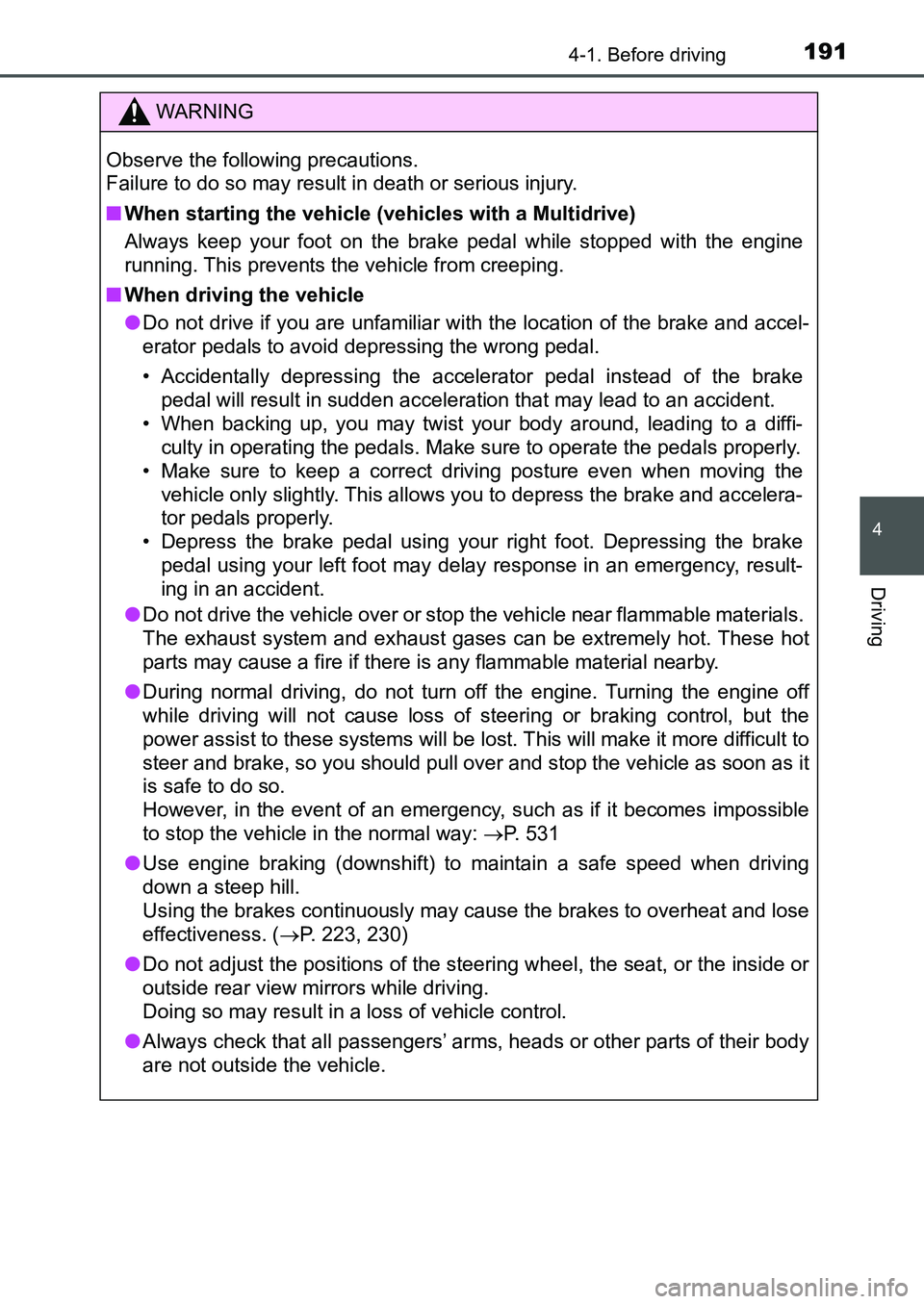
1914-1. Before driving
UK AURIS_HB_EE (OM12K97E)
4
Driving
WARNING
Observe the following precautions.
Failure to do so may result in death or serious injury.
■When starting the vehicle (vehicles with a Multidrive)
Always keep your foot on the brake pedal while stopped with the engine
running. This prevents the vehicle from creeping.
■When driving the vehicle
●Do not drive if you are unfamiliar with the location of the brake and accel-
erator pedals to avoid depressing the wrong pedal.
• Accidentally depressing the accelerator pedal instead of the brake
pedal will result in sudden acceleration that may lead to an accident.
• When backing up, you may twist your body around, leading to a diffi-
culty in operating the pedals. Make sure to operate the pedals properly.
• Make sure to keep a correct driving posture even when moving the
vehicle only slightly. This allows you to depress the brake and accelera-
tor pedals properly.
• Depress the brake pedal using your right foot. Depressing the brake
pedal using your left foot may delay response in an emergency, result-
ing in an accident.
●Do not drive the vehicle over or stop the vehicle near flammable materials.
The exhaust system and exhaust gases can be extremely hot. These hot
parts may cause a fire if there is any flammable material nearby.
●During normal driving, do not turn off the engine. Turning the engine off
while driving will not cause loss of steering or braking control, but the
power assist to these systems will be lost. This will make it more difficult to
steer and brake, so you should pull over and stop the vehicle as soon as it
is safe to do so.
However, in the event of an emergency, such as if it becomes impossible
to stop the vehicle in the normal way: P. 531
●Use engine braking (downshift) to maintain a safe speed when driving
down a steep hill.
Using the brakes continuously may cause the brakes to overheat and lose
effectiveness. (P. 223, 230)
●Do not adjust the positions of the steering wheel, the seat, or the inside or
outside rear view mirrors while driving.
Doing so may result in a loss of vehicle control.
●Always check that all passengers’ arms, heads or other parts of their body
are not outside the vehicle.
UK AURIS_HB_OM_Europe_OM12K97E.book 191 ページ 2016年6月27日 月曜日 午後5時42分
Page 192 of 661
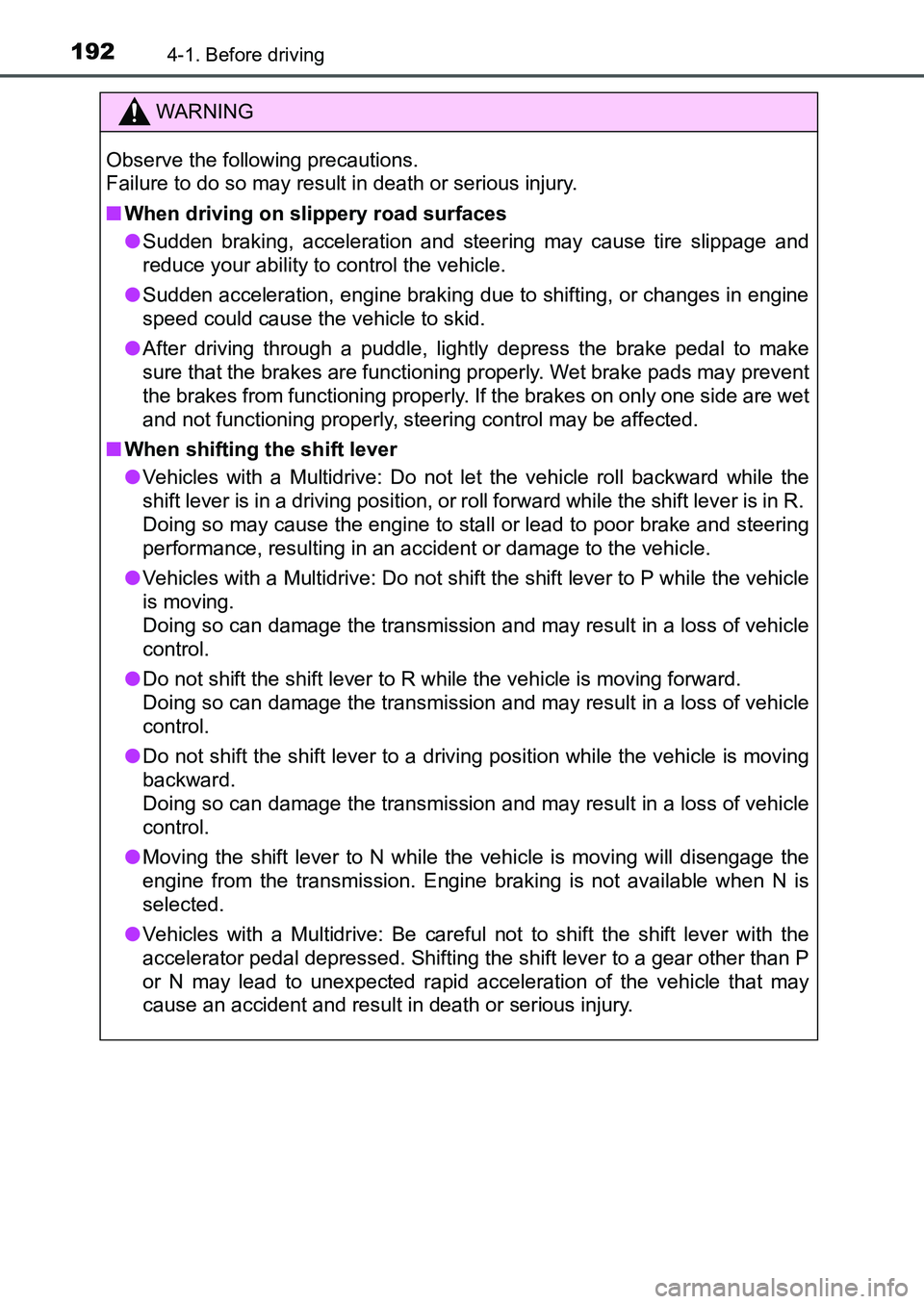
1924-1. Before driving
UK AURIS_HB_EE (OM12K97E)
WARNING
Observe the following precautions.
Failure to do so may result in death or serious injury.
■When driving on slippery road surfaces
●Sudden braking, acceleration and steering may cause tire slippage and
reduce your ability to control the vehicle.
●Sudden acceleration, engine braking due to shifting, or changes in engine
speed could cause the vehicle to skid.
●After driving through a puddle, lightly depress the brake pedal to make
sure that the brakes are functioning properly. Wet brake pads may prevent
the brakes from functioning properly. If the brakes on only one side are wet
and not functioning properly, steering control may be affected.
■When shifting the shift lever
●Vehicles with a Multidrive: Do not let the vehicle roll backward while the
shift lever is in a driving position, or roll forward while the shift lever is in R.
Doing so may cause the engine to stall or lead to poor brake and steering
performance, resulting in an accident or damage to the vehicle.
●Vehicles with a Multidrive: Do not shift the shift lever to P while the vehicle
is moving.
Doing so can damage the transmission and may result in a loss of vehicle
control.
●Do not shift the shift lever to R while the vehicle is moving forward.
Doing so can damage the transmission and may result in a loss of vehicle
control.
●Do not shift the shift lever to a driving position while the vehicle is moving
backward.
Doing so can damage the transmission and may result in a loss of vehicle
control.
●Moving the shift lever to N while the vehicle is moving will disengage the
engine from the transmission. Engine braking is not available when N is
selected.
●Vehicles with a Multidrive: Be careful not to shift the shift lever with the
accelerator pedal depressed. Shifting the shift lever to a gear other than P
or N may lead to unexpected rapid acceleration of the vehicle that may
cause an accident and result in death or serious injury.
UK AURIS_HB_OM_Europe_OM12K97E.book 192 ページ 2016年6月27日 月曜日 午後5時42分
Page 196 of 661
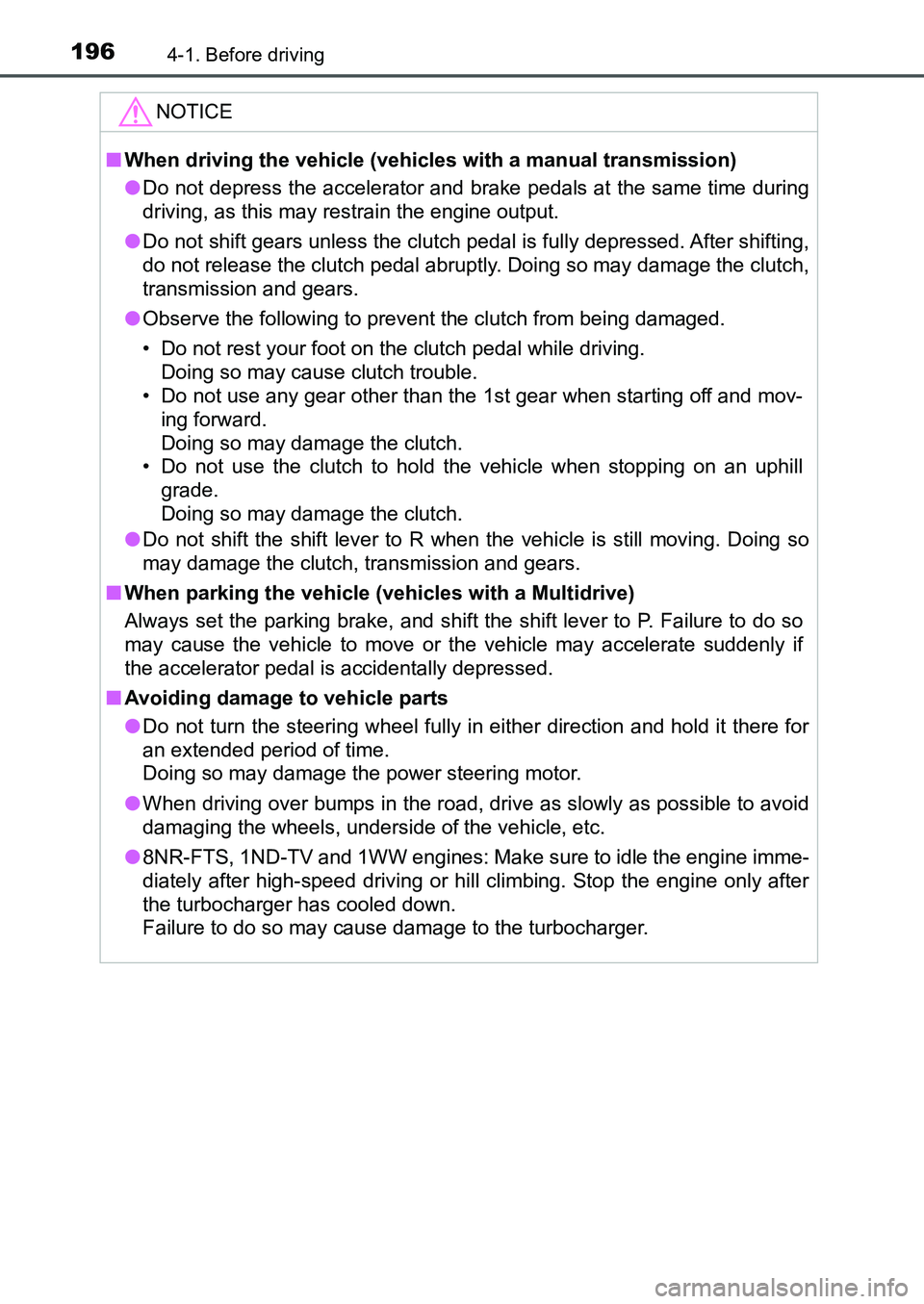
1964-1. Before driving
UK AURIS_HB_EE (OM12K97E)
NOTICE
■When driving the vehicle (vehicles with a manual transmission)
●Do not depress the accelerator and brake pedals at the same time during
driving, as this may restrain the engine output.
●Do not shift gears unless the clutch pedal is fully depressed. After shifting,
do not release the clutch pedal abruptly. Doing so may damage the clutch,
transmission and gears.
●Observe the following to prevent the clutch from being damaged.
• Do not rest your foot on the clutch pedal while driving.
Doing so may cause clutch trouble.
• Do not use any gear other than the 1st gear when starting off and mov-
ing forward.
Doing so may damage the clutch.
• Do not use the clutch to hold the vehicle when stopping on an uphill
grade.
Doing so may damage the clutch.
●Do not shift the shift lever to R when the vehicle is still moving. Doing so
may damage the clutch, transmission and gears.
■When parking the vehicle (vehicles with a Multidrive)
Always set the parking brake, and shift the shift lever to P. Failure to do so
may cause the vehicle to move or the vehicle may accelerate suddenly if
the accelerator pedal is accidentally depressed.
■Avoiding damage to vehicle parts
●Do not turn the steering wheel fully in either direction and hold it there for
an extended period of time.
Doing so may damage the power steering motor.
●When driving over bumps in the road, drive as slowly as possible to avoid
damaging the wheels, underside of the vehicle, etc.
●8NR-FTS, 1ND-TV and 1WW engines: Make sure to idle the engine imme-
diately after high-speed driving or hill climbing. Stop the engine only after
the turbocharger has cooled down.
Failure to do so may cause damage to the turbocharger.
UK AURIS_HB_OM_Europe_OM12K97E.book 196 ページ 2016年6月27日 月曜日 午後5時42分
Page 197 of 661
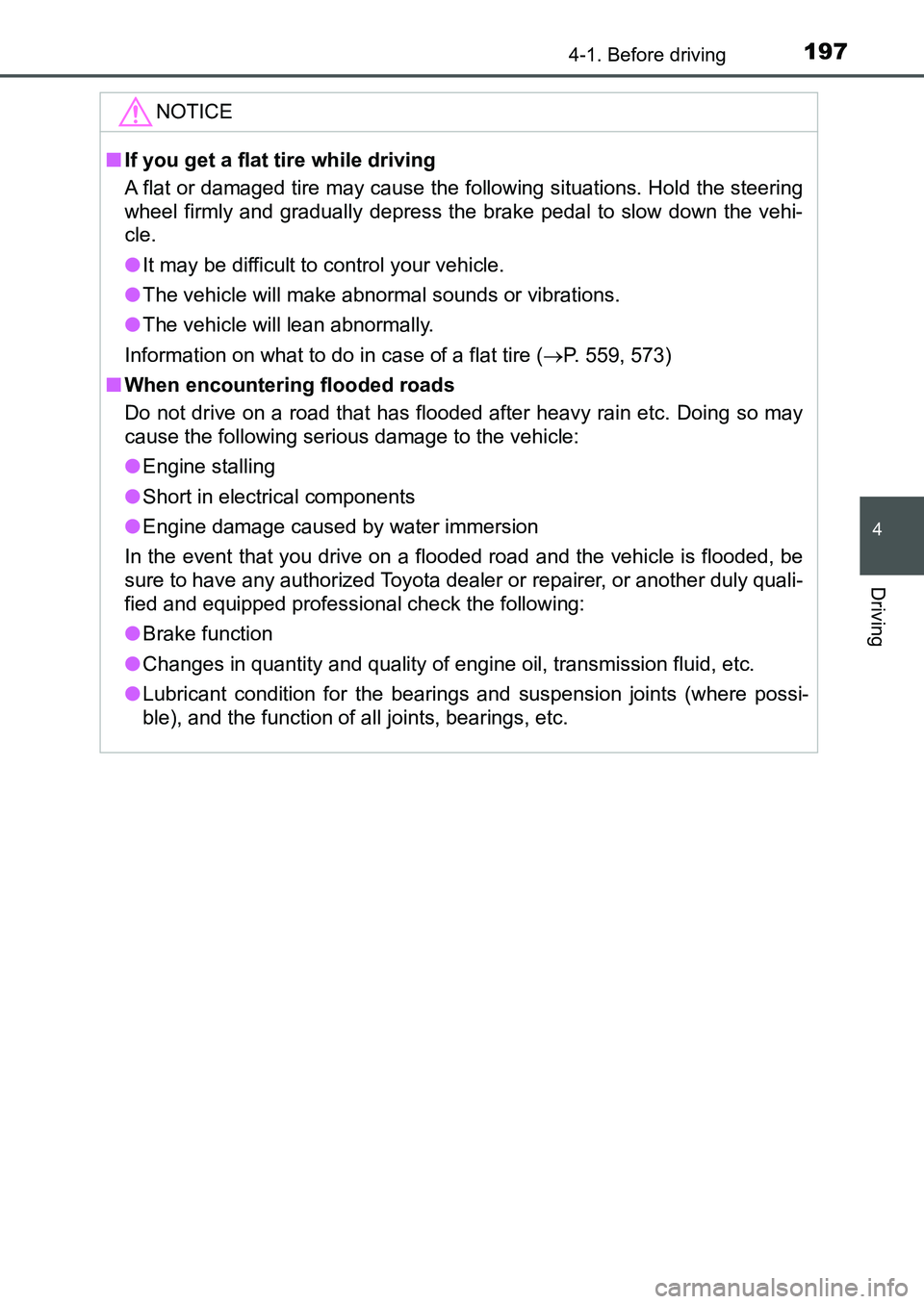
1974-1. Before driving
UK AURIS_HB_EE (OM12K97E)
4
Driving
NOTICE
■If you get a flat tire while driving
A flat or damaged tire may cause the following situations. Hold the steering
wheel firmly and gradually depress the brake pedal to slow down the vehi-
cle.
●It may be difficult to control your vehicle.
●The vehicle will make abnormal sounds or vibrations.
●The vehicle will lean abnormally.
Information on what to do in case of a flat tire (P. 559, 573)
■When encountering flooded roads
Do not drive on a road that has flooded after heavy rain etc. Doing so may
cause the following serious damage to the vehicle:
●Engine stalling
●Short in electrical components
●Engine damage caused by water immersion
In the event that you drive on a flooded road and the vehicle is flooded, be
sure to have any authorized Toyota dealer or repairer, or another duly quali-
fied and equipped professional check the following:
●Brake function
●Changes in quantity and quality of engine oil, transmission fluid, etc.
●Lubricant condition for the bearings and suspension joints (where possi-
ble), and the function of all joints, bearings, etc.
UK AURIS_HB_OM_Europe_OM12K97E.book 197 ページ 2016年6月27日 月曜日 午後5時42分
Page 198 of 661
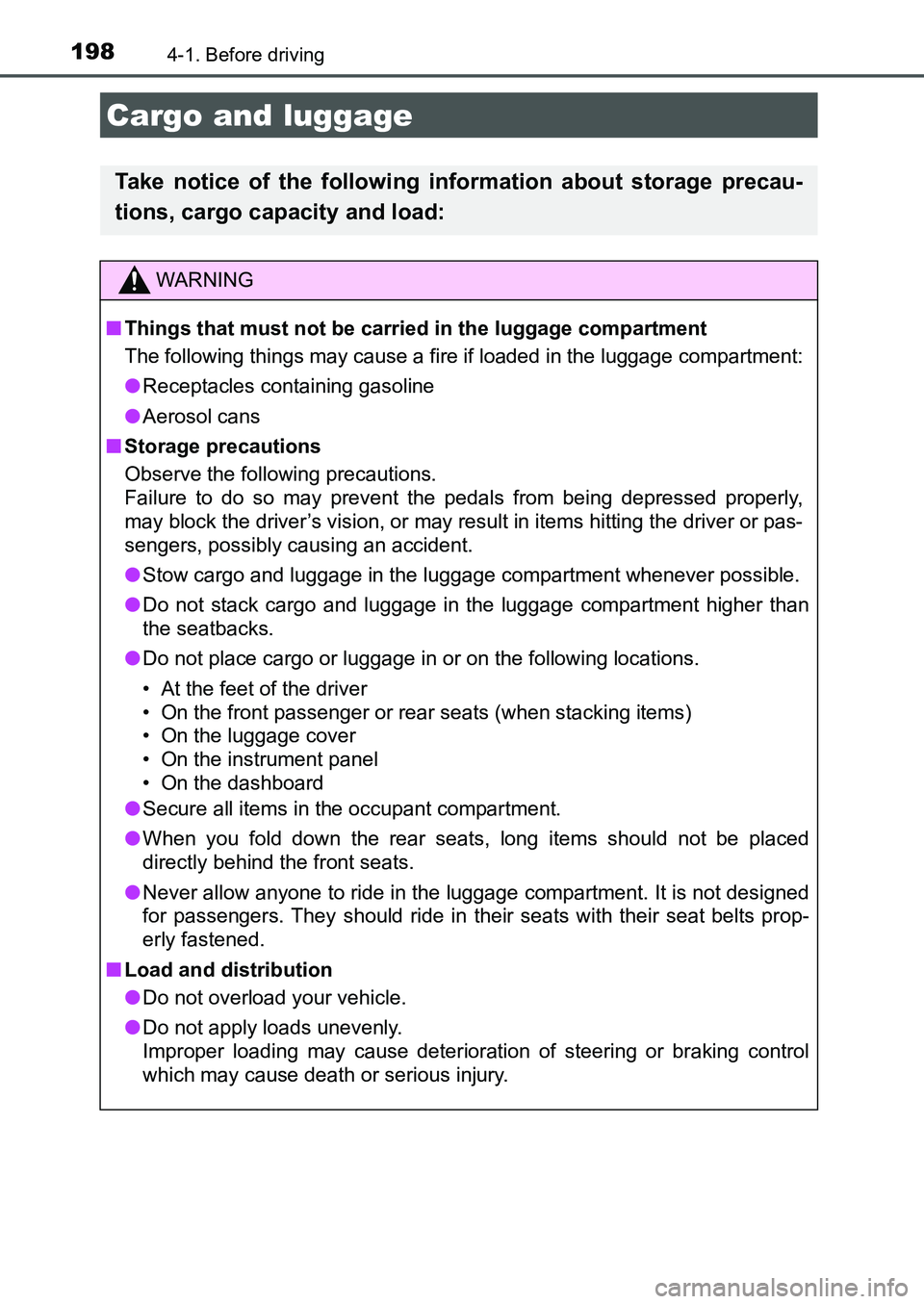
1984-1. Before driving
UK AURIS_HB_EE (OM12K97E)
Cargo and luggage
Take notice of the following information about storage precau-
tions, cargo capacity and load:
WARNING
■Things that must not be carried in the luggage compartment
The following things may cause a fire if loaded in the luggage compartment:
●Receptacles containing gasoline
●Aerosol cans
■Storage precautions
Observe the following precautions.
Failure to do so may prevent the pedals from being depressed properly,
may block the driver’s vision, or may result in items hitting the driver or pas-
sengers, possibly causing an accident.
●Stow cargo and luggage in the luggage compartment whenever possible.
●Do not stack cargo and luggage in the luggage compartment higher than
the seatbacks.
●Do not place cargo or luggage in or on the following locations.
• At the feet of the driver
• On the front passenger or rear seats (when stacking items)
• On the luggage cover
• On the instrument panel
• On the dashboard
●Secure all items in the occupant compartment.
●When you fold down the rear seats, long items should not be placed
directly behind the front seats.
●Never allow anyone to ride in the luggage compartment. It is not designed
for passengers. They should ride in their seats with their seat belts prop-
erly fastened.
■Load and distribution
●Do not overload your vehicle.
●Do not apply loads unevenly.
Improper loading may cause deterioration of steering or braking control
which may cause death or serious injury.
UK AURIS_HB_OM_Europe_OM12K97E.book 198 ページ 2016年6月27日 月曜日 午後5時42分
Page 206 of 661
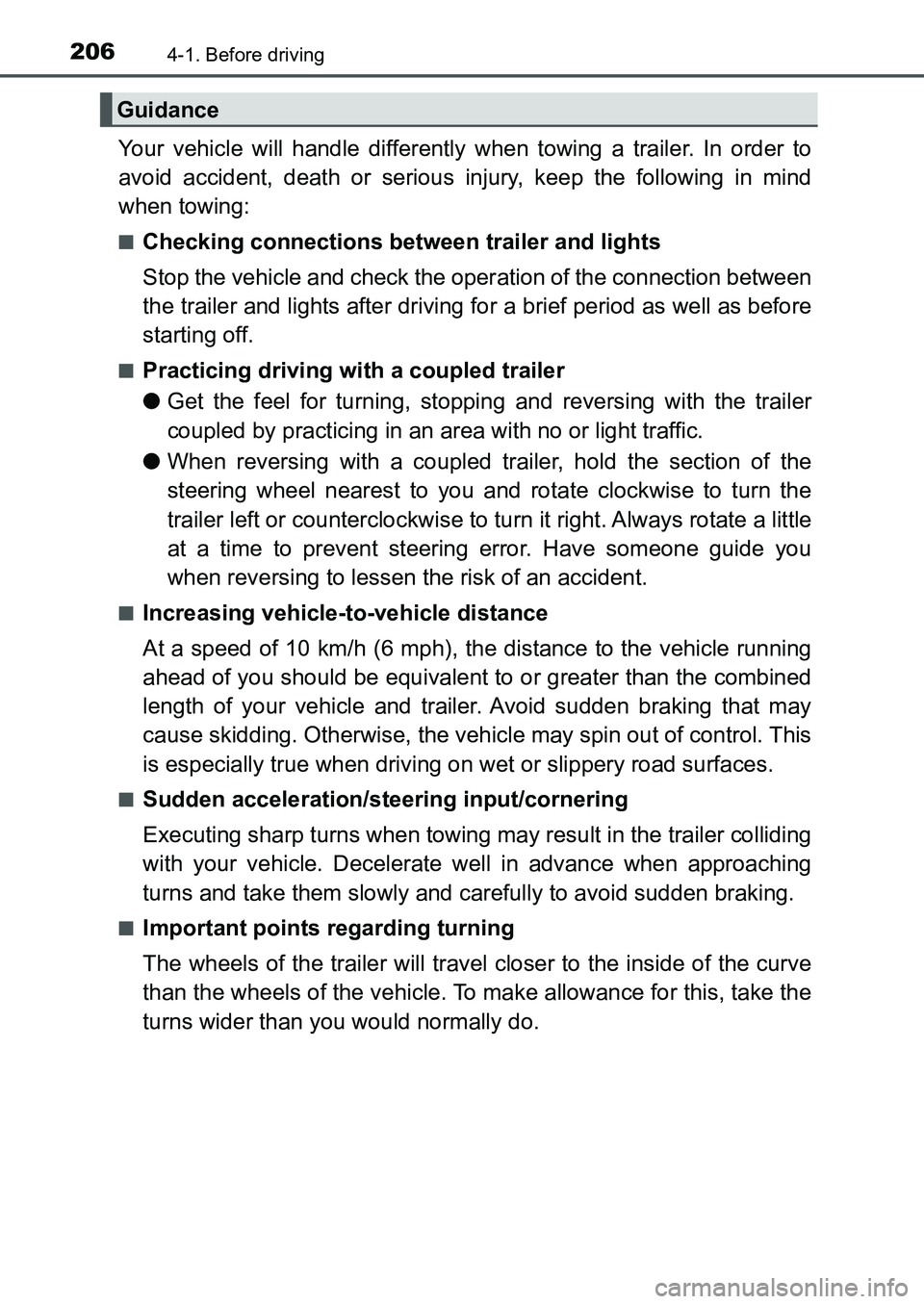
2064-1. Before driving
UK AURIS_HB_EE (OM12K97E)
Your vehicle will handle differently when towing a trailer. In order to
avoid accident, death or serious injury, keep the following in mind
when towing:
■Checking connections between trailer and lights
Stop the vehicle and check the operation of the connection between
the trailer and lights after driving for a brief period as well as before
starting off.
■Practicing driving with a coupled trailer
●Get the feel for turning, stopping and reversing with the trailer
coupled by practicing in an area with no or light traffic.
●When reversing with a coupled trailer, hold the section of the
steering wheel nearest to you and rotate clockwise to turn the
trailer left or counterclockwise to turn it right. Always rotate a little
at a time to prevent steering error. Have someone guide you
when reversing to lessen the risk of an accident.
■Increasing vehicle-to-vehicle distance
At a speed of 10 km/h (6 mph), the distance to the vehicle running
ahead of you should be equivalent to or greater than the combined
length of your vehicle and trailer. Avoid sudden braking that may
cause skidding. Otherwise, the vehicle may spin out of control. This
is especially true when driving on wet or slippery road surfaces.
■Sudden acceleration/steering input/cornering
Executing sharp turns when towing may result in the trailer colliding
with your vehicle. Decelerate well in advance when approaching
turns and take them slowly and carefully to avoid sudden braking.
■Important points regarding turning
The wheels of the trailer will travel closer to the inside of the curve
than the wheels of the vehicle. To make allowance for this, take the
turns wider than you would normally do.
Guidance
UK AURIS_HB_OM_Europe_OM12K97E.book 206 ページ 2016年6月27日 月曜日 午後5時42分
Page 210 of 661
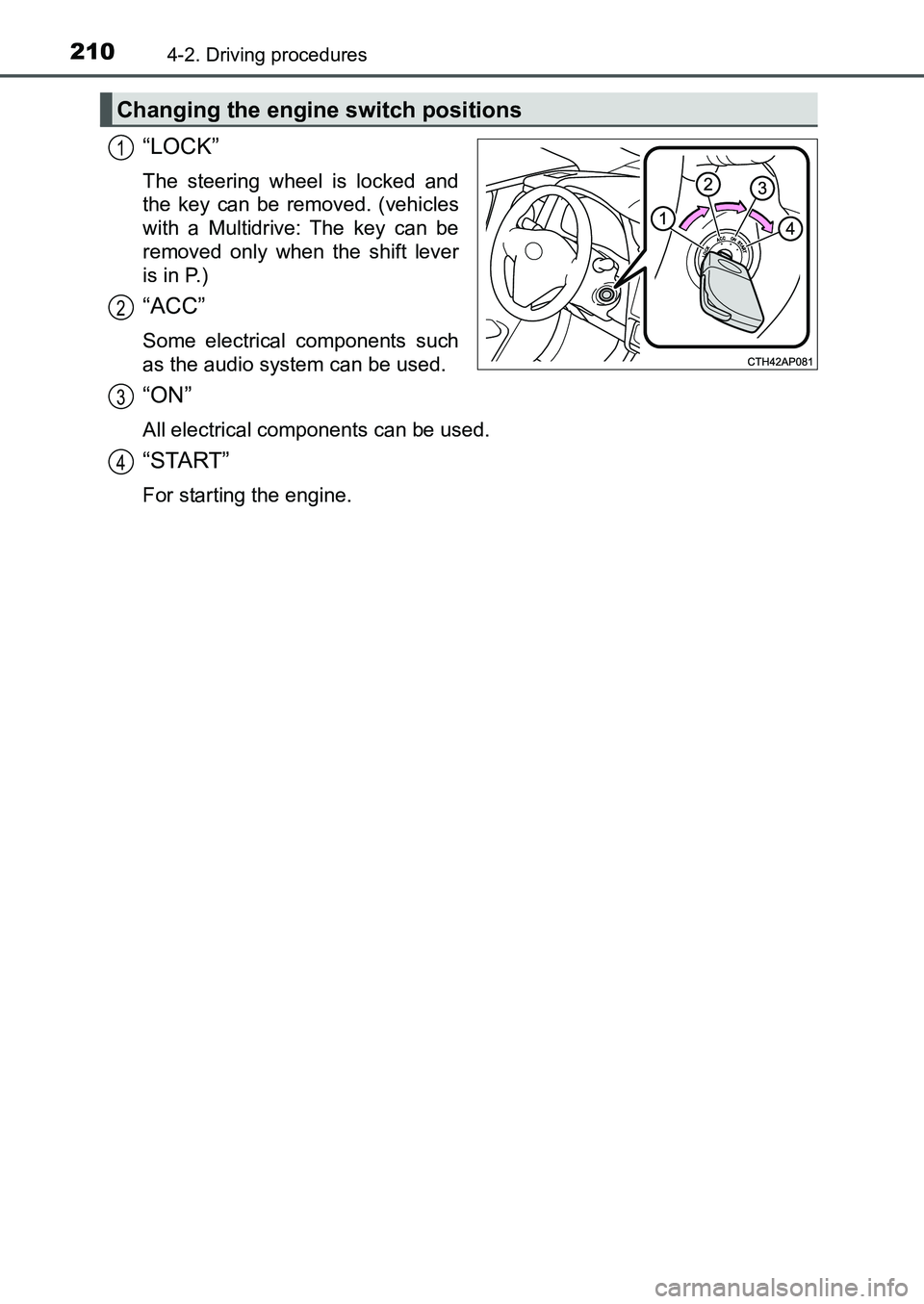
2104-2. Driving procedures
UK AURIS_HB_EE (OM12K97E)
“LOCK”
The steering wheel is locked and
the key can be removed. (vehicles
with a Multidrive: The key can be
removed only when the shift lever
is in P.)
“ACC”
Some electrical components such
as the audio system can be used.
“ON”
All electrical components can be used.
“START”
For starting the engine.
Changing the engine switch positions
1
2
3
4
UK AURIS_HB_OM_Europe_OM12K97E.book 210 ページ 2016年6月27日 月曜日 午後5時42分